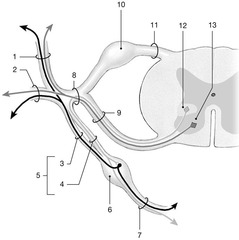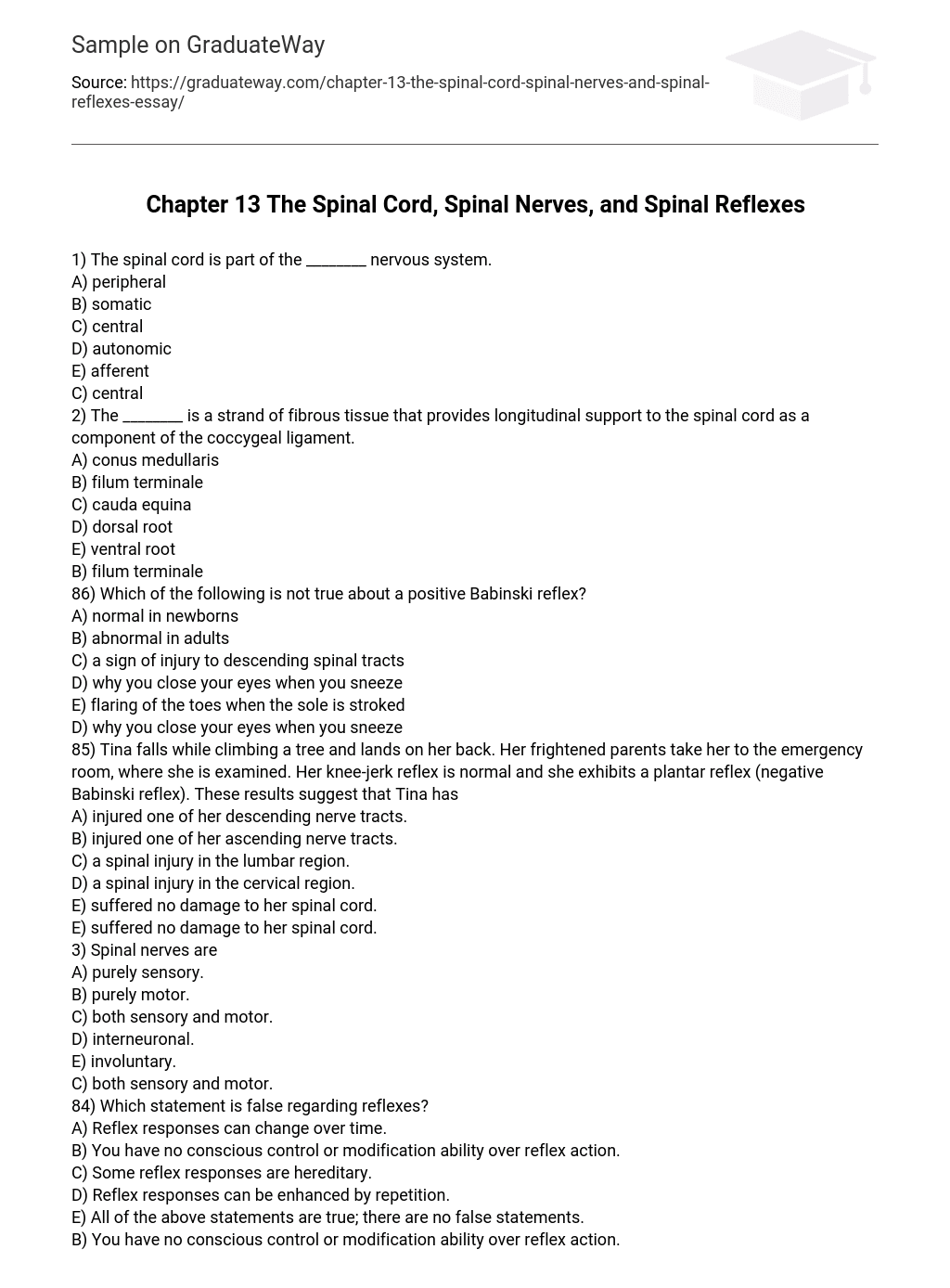A) peripheral
B) somatic
C) central
D) autonomic
E) afferent
A) conus medullaris
B) filum terminale
C) cauda equina
D) dorsal root
E) ventral root
A) normal in newborns
B) abnormal in adults
C) a sign of injury to descending spinal tracts
D) why you close your eyes when you sneeze
E) flaring of the toes when the sole is stroked
A) injured one of her descending nerve tracts.
B) injured one of her ascending nerve tracts.
C) a spinal injury in the lumbar region.
D) a spinal injury in the cervical region.
E) suffered no damage to her spinal cord.
A) purely sensory.
B) purely motor.
C) both sensory and motor.
D) interneuronal.
E) involuntary.
A) Reflex responses can change over time.
B) You have no conscious control or modification ability over reflex action.
C) Some reflex responses are hereditary.
D) Reflex responses can be enhanced by repetition.
E) All of the above statements are true; there are no false statements.
A) five
B) twelve
C) twenty-five
D) thirty-one
E) The number varies widely among individuals.
A) a monosynaptic reflex
B) a polysynaptic reflex
A) axons of motor neurons.
B) axons of sensory neurons.
C) cell bodies of motor neurons.
D) cell bodies of sensory neurons.
E) synapses.
A) prevents a muscle from overstretching.
B) prevents a muscle from generating damaging tension.
C) moves a limb away from a painful stimulus.
D) usually depends on cranial neurons.
E) is an example of a monosynaptic reflex.
A) axons of motor neurons.
B) axons of sensory neurons.
C) cell bodies of motor neurons.
D) cell bodies of sensory neurons.
E) interneurons.
A) stretch
B) tendon
C) flexor
D) crossed extensor
E) reciprocal
A) axons of motor neurons.
B) axons of sensory neurons.
C) cell bodies of motor neurons.
D) cell bodies of sensory neurons.
E) interneurons.
A) a crossed extensor reflex.
B) a stretch reflex.
C) a tendon reflex.
D) reciprocal inhibition.
E) reverberating circuits.
A) arachnoid.
B) pia mater.
C) dura mater.
D) epidural block.
E) periosteum.
A) stretch
B) tendon
C) flexor
D) crossed extensor
E) reciprocal
A) 8
B) 12
C) 18
D) 4
E) 1
A) are found within skeletal muscle.
B) consist of specialized fibers called intrafusal fibers.
C) are found in tendons.
D) are the receptor for the stretch reflex.
E) are innervated by gamma motor neurons.
A) output to skeletal muscles would be blocked.
B) output to visceral organs would be blocked.
C) the spinal cord would not be able to process information at that level.
D) the brain would not be able to communicate with that level of the spinal cord.
E) sensory input would be blocked.
A) their development.
B) where information processing occurs.
C) the motor response.
D) the complexity of the neural circuit.
E) whether they are sensory or motor.
A) the arachnoid mater and the pia mater.
B) the pia mater and the dura mater.
C) the dura mater and the arachnoid mater.
D) the pia mater and the subarachnoid space.
E) the endosteum and the periosteum.
A) visceral
B) innate
C) acquired
D) somatic
E) vegetative
A) dura mater.
B) subarachnoid space.
C) arachnoid.
D) pia mater.
E) choroid plexus.
A) are automatic motor responses.
B) are the simplest form of behavior.
C) help preserve homeostasis.
D) cannot be modified by the brain.
E) involve at least two neurons.
A) cervical enlargement.
B) lumbar enlargement.
C) spinal nerve.
D) spinal meninx.
E) spinal ganglion.
A) parallel
B) reverberation
C) serial
D) convergent
E) consensual
A) inflammation of the meninges occurs.
B) bacteria can be the cause.
C) viruses can be the cause.
D) CSF flow can be disrupted.
E) All of the answers are correct.
A) It is commonly used as a method of pain control during labor and delivery.
B) It affects only the spinal nerves in the immediate area of the injection.
C) It can provide sensory and motor anesthesia, depending on the anesthetic selected.
D) It can provide mainly sensory anesthesia, depending on the anesthetic selected.
E) All of the answers are correct.
A) convergent.
B) divergent.
C) multipolar.
D) reverberating.
E) parallel processing.
A) 4
B) 6
C) 5
D) 10
E) 12
A) filum terminale.
B) subarachnoid space.
C) dura mater.
D) pia mater.
E) arachnoid mater.
A) 1
B) 2
C) 5
D) 7
E) 11
A) 20 years.
B) 10 years.
C) 4 years.
D) 6 months.
E) 2 months.
A) somatic motor control
B) visceral motor control
C) somatic sensory input
D) visceral sensory input
E) sensory receptor for pain
A) cranial meninges.
B) cranial mater.
C) spinal meninges.
D) spinal mater.
E) epidural membranes.
A) peripheral nerve
B) dorsal ramus
C) spinal nerve
D) ventral root
E) dorsal root
A) pia mater.
B) dura mater.
C) epidural space.
D) subdural space.
E) subarachnoid space.
A) autonomic nerve
B) sympathetic ganglion
C) dorsal root ganglion
D) rami communicantes
E) ventral root
A) dura mater.
B) arachnoid mater.
C) epidural space.
D) subarachnoid space.
E) cerebral ventricles.
A) autonomic nerve
B) autonomic ganglion
C) rami communicantes
D) dorsal root ganglion
E) ventral root
A) T6.
B) T10.
C) L1.
D) L5.
E) C1.
A) preganglionic neuron
B) postganglionic neuron
C) somatic motor neuron
D) sensory neuron
E) interneuron
A) loss of sensation in his torso
B) inability to breathe
C) problems with moving his arms
D) uncontrollable sweating of his feet
E) problems moving his legs
A) spinal nerve
B) gray ramus
C) white ramus
D) dorsal ramus
E) ventral ramus
A) unmyelinated axons.
B) neuroglia.
C) Schwann cells.
D) myelinated axons.
E) nodes of Ranvier.
A) spinal nerve
B) gray ramus
C) white ramus
D) dorsal ramus
E) ventral ramus
A) nerve tracts.
B) columns.
C) meninges.
D) neuron cell bodies.
E) funiculi.

A) ventral root
B) dorsal ramus
C) spinal nerve
D) ventral ramus
E) white ramus
A) sensory nuclei.
B) somatic motor nuclei.
C) autonomic motor nuclei.
D) nerve tracts.
E) sympathetic nuclei.
A) radial.
B) median.
C) ulnar.
D) musculocutaneous.
E) phrenic.
A) sensory nuclei.
B) somatic motor nuclei.
C) autonomic motor nuclei.
D) nerve tracts.
E) sympathetic nuclei.
A) the anterior gray horns
B) the anterior gray commissures
C) ascending tracts
D) descending tracts
E) the anterior white commissures
A) central canal.
B) posterior gray horns.
C) gray commissures.
D) white columns.
E) anterior gray horns.
A) perineal
B) femoral
C) brachial
D) pudendal
E) sciatic
A) nuclei.
B) ganglia.
C) columns.
D) nerves.
E) horns.
A) might be unable to breathe on his own.
B) could walk without difficulty.
C) would have full range of motion in all extremities.
D) would be in a coma.
E) would have difficulty chewing and moving the tongue.
A) wings.
B) horns.
C) pyramids.
D) fibers.
E) tracts.
A) brachial
B) lumbar
C) sacral
D) nuchal
E) cervical
A) anterior gray horns.
B) lateral gray horns.
C) posterior gray horns.
D) gray commissures.
E) white commissures.
A) endoneurium.
B) perineurium.
C) aponeurium.
D) metaneurium.
E) subneurium.
A) bundles of axons with common origins, destinations, and functions.
B) bundles of dendrites with common origins, destinations, and functions.
C) sensory and motor nuclei.
D) both axons and dendrites.
E) interneurons.
A) ansa cervicalis
B) lesser occipital
C) radial
D) phrenic
E) sciatic

A) anterior white column
B) lateral white column
C) lateral white horn
D) median commissure
E) posterior white column
A) saphenous
B) sciatic
C) femoral
D) obturator
E) genitofemoral
A) posterior gray column
B) dorsal gray ganglion
C) posterior white column
D) posterior gray horn
E) anterior gray horn
A) dermatome.
B) autonomic nerve.
C) lateral nerve.
D) tract.
E) plexus.
A) anterior white commissure
B) anterior median fissure
C) anterior white column
D) anterior gray commissure
E) anterior white horn
A) control of skeletal muscle
B) somatic sensory receiving
C) visceral sensory receiving
D) control of visceral effectors
E) ascending pathway
A) lead to skeletal muscle weakness or paralysis.
B) interfere with position sense.
C) mainly interfere with crude touch and temperature sense.
D) block autonomic regulation.
E) affect visceral motor function.
A) adductors of the hip.
B) skin over the perineum.
C) extensors of the hip.
D) skin over buttocks.
E) biceps femoris.
A) control of skeletal muscle
B) somatic sensory processing
C) control of visceral effectors
D) somatic motor control
E) visceral sensory processing
A) white rami communicantes
B) gray rami communicantes
C) dorsal ramus
D) ventral ramus
E) dermatomes
A) 10
B) 12
C) 13
D) 14
E) 15
A) perineurium.
B) epineurium.
C) endoneurium.
D) epimysium.
E) endosteum.
A) the subarachnoid space
B) the central canal
C) the subdural space
D) the epidural space
E) the venous dural sinus
A) shoulder
B) intercostal
C) abdominal
D) leg
E) facial
A) endoneurium.
B) endomysium.
C) perineurium.
D) epineurium.
E) epimysium.
A) myasthenia gravis
B) neuronal damage
C) shingles
D) chickenpox
E) Hodgkin’s disease
A) white rami communicantes.
B) gray rami communicantes.
C) dorsal ramus.
D) ventral ramus.
E) dermatomes.
A) white rami communicantes.
B) gray rami communicantes.
C) dorsal ramus.
D) ventral ramus.
E) dermatomes.
A) cranial
B) cervical
C) brachial
D) lumbar
E) sacral
A) cervical
B) brachial
C) lumbar
D) sacral
E) thoracic
A) dorsal rami.
B) ventral rami.
C) white rami.
D) gray rami.
E) sympathetic nerves.
A) white ramus communicantes
B) gray ramus communicantes
C) dorsal ramus
D) ventral ramus
E) dermatome
A) 8 cervical spinal nerves
B) 11 thoracic spinal nerves
C) 5 lumbar spinal nerves
D) 5 sacral spinal nerves
E) 1 coccygeal spinal nerve
A) cervical
B) thoracic
C) lumbar
D) sacral
E) coccygeal





